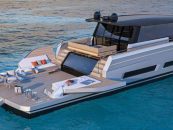Ah, the humble flathead… A lot has been written on this fish. Why? This fish is a fantastic sports fish to target with different methods. Just look at the success of the Flathead Classic, held every September by the Gold Coast Sports Fishing Club. In my opinion, the best comp on the Goldie! I personally look forward to this comp every year. My wife Megan was lucky enough to take out first place for the female anglers last year and was runner up the year before that. This year, we have added an extra member to our team to make ourselves a team of 3. I will let you know how we go in my next article… Oh, back to the flathead.
Any fish over the 70cm mark will put up a cracking fight. Even though sometimes a big croc can be a bit asleep at the start of a fight, it can explode once it realises it is hooked.
My 6-year-old son, Koby, caught one of these crocs that took off like a Ferrari in shallow water. The fish went right up in the shallows to the point where I couldn’t get the boat anywhere near the fish. Koby’s arm started to feel the pinch and he wanted to pass the rod over. I said, “Mate, this is a big one. You can do it!” He did a massive 78cm flatty slide into the net. Then, I said, in a proud dad moment, “A lot of my mates have never pulled in a fish of this size!” For me, this is what fishing is all about, passing on what you have learned to the future fishermen and fisherwomen. So here are a few pointers to help you land that big croc.
GEAR UP
Using lures, hard or soft, is a style of fishing that is relatively easy to do. I have been enoying doing it for the last 15 plus years. The first important thing is to make sure you have the right gear for the job. When people tell me that they have no success fishing with lures, I ask two questions: (1) What pound line did you use? and (2) What pound leader?
Line type and weight are very critical to how the lure acts underwater. The difference of a few pounds here and a finer diameter braid can be all the difference in the way a lure swims and the depth that it will dive to. So in saying this, I use the thinnest 6lb braid I can find. As for the leader, I have tried a lot of different brands of fluoro-carbon leader. As long as you stay around 8lb to 10lb, you are on your way. What I have found, talking to other lure fanatics, is to keep the leader length around 600mm to 800mm. A good mate of mine caught his personal best (88cm flatty) on 6lb main line and 8lb leader length was around 500mm. Super fun on light line. I previously used 4lb main line but from my experience of fishing in the Flathead Classic, having a slightly heavier line is beneifical. Now I know some people prefer to use heavier line for the big girls, but this is what works for me in the shallows.
LOCATE THE FISH
Now that you have the gear sorted, all you need to do is find a good location. First thing I do when fishing a new location is to search on Google maps and look over the area for dark patches (weed/rocks, deep water and shallow water). Next, I would visit the area in my boat. I would head there at low tide and check out the exposed bank, firstly from the boat and then mark any drains I could see. I like drains that completely dry out so the flathead cannot be anywhere but out in front of the drain. Why, you may ask. The flathead is an ambush predator. They half-bury their bodies in the sand waiting for an unsuspecting bait fish to swim past, then ‘smack,’ with lightning reflexes, they pounce.
The reason I look for the drain: Think of the banks as a suburb of houses and the drain as the main road. Most of the traffic is on the main road on the way to and from work. This is the same for fish, on the making tide (incoming) the bait and other small fish move into these drains. As soon as there is enough water to get on the bank to forage for food, they are there. But as the tide falls, the last place the bait fish can hide is in the drains as it is the deepest part of the bank. The flatties will not be far away. I have caught 20 to 30 flathead in the last hour of the run-out tide using this method.
Another thing to do on low tide is to walk along the banks, looking for indentations that the flathead leave. When you locate a few, troll or throw plastics at this location when the tide allows. Trolling in between weed banks is good too, but entails a bit more work. If the weed gets on the lure, you need to pull it in, and remove the weed then put the lure back out again. The weed gives the flathead the perfect cover.
Don’t think just because the water is only shin-deep that there are no fish there. I have seen some of the biggest fish come from this amount of water. I know a lot of people fish the deep water for the big girls, but there are just as many in the shallows.
USE LURES AND PLASTICS
When you pick up a few on lures in a short amount of time, don’t be afraid to pull in the hard body lures and pepper the area with large plastics. This method has accounted for some big fish.
Using plastics for flathead has exploded over the last 15 or so years. Every size plastic from 2-inch curl tails to 11-inch plus jerk shads works. My preferred plastics are the 3-inch curl tails and the 4-inch paddle tails. I use the 4-inch Gobblers paddle tail most of the time. First, it gives off more sound in the dirty water, and second, it has awesome action and a bit more weight to give more casting distance.
With the paddle tail, I match it with a 1/6 or 1/4 TT jig head, as I usually fish in shallow water. The action I find that works is to cast and then let the plastic hit the bottom, lift the rod tip so the plastic lifts 50cm or so, and then drop back to the bottom. Pause and repeat. Make sure to wind in the slack line to keep in contact with the plastic, as the flatty will hit on the drop.
My favourite colour in the Gobblers range is Aged Copper and Pink Glow. With the curl tails, same jig head, cast out, let it hit the bottom, then “slow roll” it back in with one or two pauses. In the clean waters, I find that this method works really well. My favourite colour in the Gobblers curl tail is Diablo.
The next factor to think about with lures are the colours you are using. There is an infinite amount of colours to choose from but rule of thumb is “dark lure, dark day” and “light lure, light day”. Same goes for water clarity – the dirtier the water the darker the lure; the cleaner the water, the lighter the lure. The Gobblers range of plastics have this colour spectrum well covered, which is manufactured and developed right here in Southeast Queensland.
As the saying goes: “More lures catch fisherman and fisherwomen than catch fish”. I bought lures that look awesome, but when I put them in the water, the action has a lot to be desired. I spend decent money on decent gear. The same for lures.
The Zerek range of lures work! First is the Tango Shad. This lure was pretty much all we trolled with in the last couple of years of Flathead Classic, and have landed 100s of fish. Another lure is the “Crossfire”, released in only the last couple of years. The difference is that it swims near the surface. It is awesome to watch some of the surface takes. The trusty Halco lures have been around for many years and are proven “catchers”. I have been using a “top secret” lure for the past 6 months and it has performed above expectations. Keep an eye out for more on this awesome lure in the future!
TROLL
I find that I have more success trolling with the tide. On my boat, I currently have a 50hp Yamaha four-stroke tilt steer. This has buttons on the side that allows me to “up” or lower the revs, so I am able to go as slow as possible with the lure working, meaning it is vibrating in the water and touching the bottom every now and then, not just floating. The tip of your rod will tell you if the lure is working or not. If your rod stops vibrating, then you know that something is touching it, like weeds. If that’s the case, pull it in and clean it. With flatties, the longer you can keep the lure in the “strike zone’, the better.
Don’t think you need to run the lure way out the back of your boat, as this can have an adverse affect and make your lure rise up in the water. I like to troll between 5m to 15m out the back with the motor puffing up sand. The flathead get inquisitive and come up for a look. Then, Bang! You are on! I have caught plenty of fish 4 metres from the boat in 400mm of water.
SPAWNING SEASON
Around October, the flathead are schooling up to spawn. There will usually be one larger female to several other smaller males. With the flathead spawning you will find a lot of fishermen targeting areas like Jumpinpin and Southport Seaway.
I personally like to be a little bit away from these areas as the amount of boat traffic drives me crazy. I like to find a quiet stretch of water and methodically work it. I trolled some new ground around Jumpinpin way with the Tango and Bulldog. I noticed a dark and light area. This was a small ledge of around 400mm. With the tide running the right way over the ledge, I began trolling. The lure had not been in the water for 15 seconds, and I was on to a little 5-pointer, shook him off and placed the lure back. No sooner had I put the bale arm over – bang! – I was on again. This was a better fish, in the early 50cms. By this time, my deckie was complaining that he had not even got his line in the water. This happened a few more times. In the end, we travelled probably 100m for 4 or 5 more flathead. This was from putting a few things I have mentioned into place.
Keep livin’ the dream!
By Matty Savas
You can read more of Matty’s adventures and advice at www.fishflickers.com.au.

























